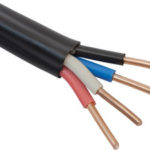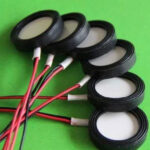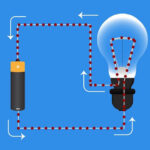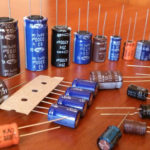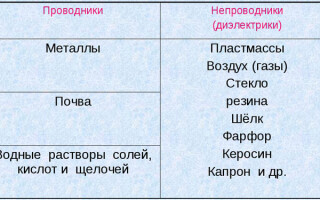Conductors and dielectrics are physical substances that have different degrees of electrical conductivity and react differently to the action of an electric field. The opposite properties of materials are widely used in all areas of electrical engineering.
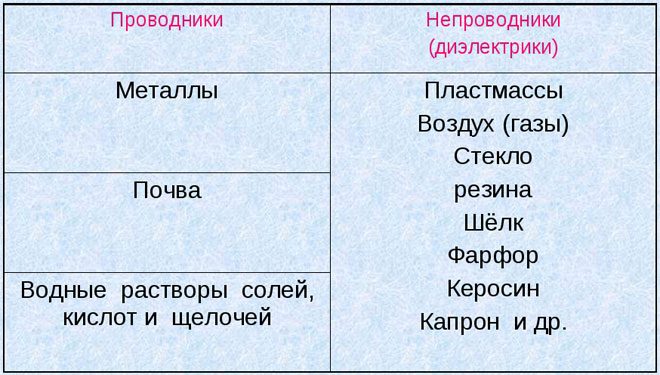
Content
What are conductors and dielectrics
conductors - substances with free electric charges capable of moving directionally under the influence of an external electric field. These features are:
- metals and their melts;
- natural carbon (coal, graphite);
- electrolytes - solutions of salts, acids and alkalis;
- ionized gas (plasma).
The main property of materials: free charges - electrons in solid conductors and ions in solutions and melts, moving throughout the entire volume of the conductor, conduct electric current.Under the influence of an electrical voltage applied to the conductor, a conduction current is created. Resistivity and electrical conductivity are the main indicators of the material.
The properties of dielectric materials are opposite to those of conductors electricity. Dielectrics (insulators) - consist of neutral atoms and molecules. They do not have the ability to move charged particles under the influence of an electric field. Dielectrics in an electric field accumulate uncompensated charges on the surface. They form an electric field directed inside the insulator, the dielectric is polarized.
As a result of polarization, the charges on the surface of the dielectric tend to reduce the electric field. This property of electrical insulating materials is called the dielectric constant of the dielectric.
Characteristics and physical properties of materials
The parameters of the conductors determine the scope of their application. Main physical characteristics:
- electrical resistivity - characterizes the ability of a substance to prevent the passage of electric current;
- temperature coefficient of resistance - a value that characterizes the change in the indicator depending on temperature;
- thermal conductivity - the amount of heat passing per unit time through a layer of material;
- contact potential difference - occurs when two dissimilar metals come into contact, is used in thermocouples for temperature measurement;
- tensile strength and tensile elongation - depends on the type of metal.
When cooled to critical temperatures, the resistivity of the conductor tends to zero. This phenomenon is called superconductivity.
Properties characterizing the conductor:
- electrical - resistance and electrical conductivity;
- chemical - interaction with the environment, anti-corrosion, the ability to connect by welding or soldering;
- physical - density, melting point.
A feature of dielectrics is to resist the effects of electric current. Physical properties of electrical insulating materials:
- dielectric constant - the ability of insulators to polarize in an electric field;
- specific volume resistance;
- electrical strength;
- dielectric loss tangent.
Insulating materials are characterized by the following parameters:
- electrical - the magnitude of the breakdown voltage, electrical strength;
- physical - heat resistance;
- chemical - solubility in aggressive agents, moisture resistance.
Types and classification of dielectric materials
Insulators are divided into groups according to several criteria.
Classification according to the state of aggregation of a substance:
- solid - glass, ceramics, asbestos;
- liquid - vegetable and synthetic oils, paraffin, liquefied gas, synthetic dielectrics (silicon and organofluorine compounds freon, freon);
- gaseous - air, nitrogen, hydrogen.
Dielectrics can be of natural or artificial origin, of organic or synthetic nature.
Organic natural insulating materials include vegetable oils, cellulose, and rubber. They are characterized by low thermal and moisture resistance, rapid aging. Synthetic organic materials are various types of plastic.
Inorganic dielectrics of natural origin include: mica, asbestos, muscovite, phlogopite. Substances are resistant to chemical attack, withstand high temperatures.Artificial inorganic dielectric materials - glass, porcelain, ceramics.
Why do dielectrics not conduct electricity?
Low conductivity is due to the structure of dielectric molecules. Particles of matter are closely related to each other, they cannot leave the atom and move throughout the entire volume of the material. Under the influence of an electric field, the particles of an atom are able to slightly loosen - to polarize.
Depending on the mechanism of polarization, dielectric materials are divided into:
- non-polar - substances in various states of aggregation with electronic polarization (inert gases, hydrogen, polystyrene, benzene);
- polar - have dipole-relaxation and electronic polarization (various resins, cellulose, water);
- ionic - solid dielectrics of inorganic origin (glass, ceramics).
The dielectric properties of a substance are not constant. Under the influence of high temperature or high humidity, electrons break away from the nucleus and acquire the properties of free electric charges. The insulating qualities of the dielectric in this case are reduced.
A reliable dielectric is a material with a low leakage current that does not exceed a critical value and does not disrupt the operation of the system.
Where are dielectrics and conductors used?
The materials are used in all areas of human activity where electric current is used: in industry, agriculture, instrumentation, electrical networks and household appliances.
The choice of conductor is determined by its technical characteristics. Products made of silver, gold, platinum have the lowest resistivity.Their use is limited to space and military purposes due to the high cost. Copper and aluminum conduct current somewhat worse, but their comparative cheapness has led to their widespread use as wires and cable products.
Pure metals without impurities conduct current better, but in some cases it is required to use conductors with high resistivity - for the production of rheostats, electric furnaces, and electric heaters. For these purposes, alloys of nickel, copper, manganese (manganin, constantan) are used. The electrical conductivity of tungsten and molybdenum is 3 times lower than that of copper, but their properties are widely used in the production of electric lamps and radio devices.
Solid dielectrics are materials that ensure the safety and uninterrupted operation of conductive elements. They are used as an electrical insulating material, preventing current leakage, isolate the conductors from each other, from the device case, from the ground. An example of such a product is dielectric gloves, which are described in our article.
Liquid dielectrics are used in capacitors, power cables, circulating cooling systems of turbogenerators and high-voltage oil circuit breakers. Materials are used as filling and impregnation.
Gaseous insulating materials. Air is a natural insulator that also provides heat dissipation. Nitrogen is used in places where oxidative processes are unacceptable. Hydrogen is used in powerful generators with high heat capacity.
The coordinated work of conductors and dielectrics ensures the safe and stable operation of equipment and power supply networks. The choice of a specific element for the task in hand depends on the physical properties and technical parameters of the substance.
Similar articles:

